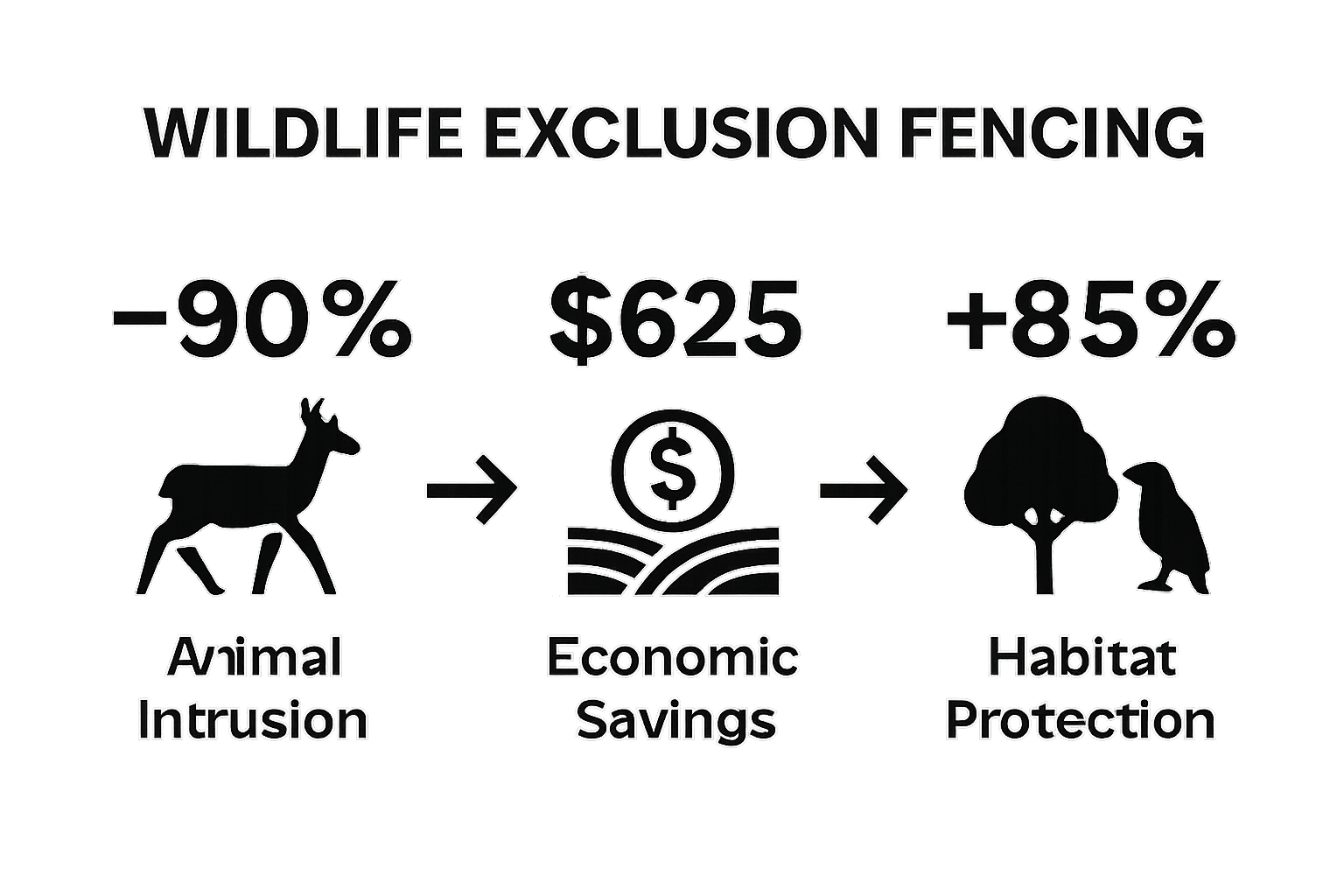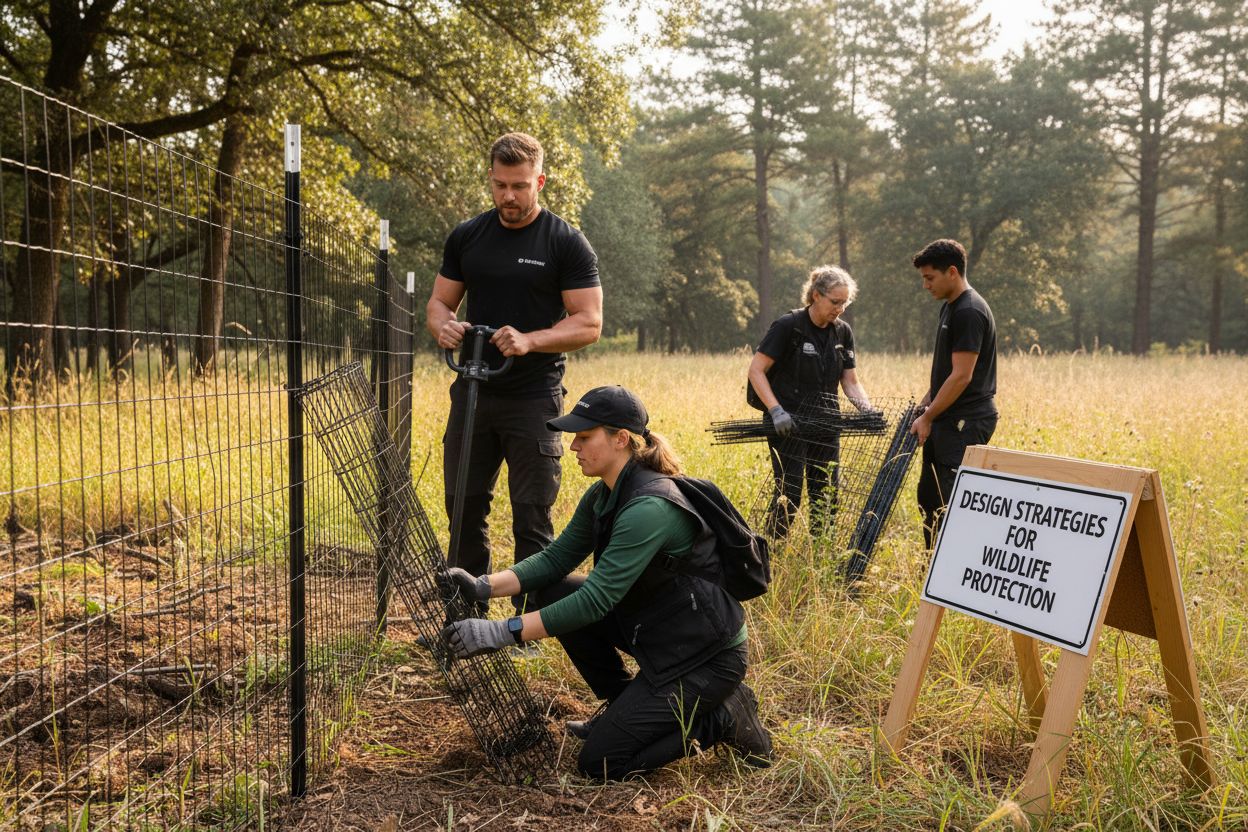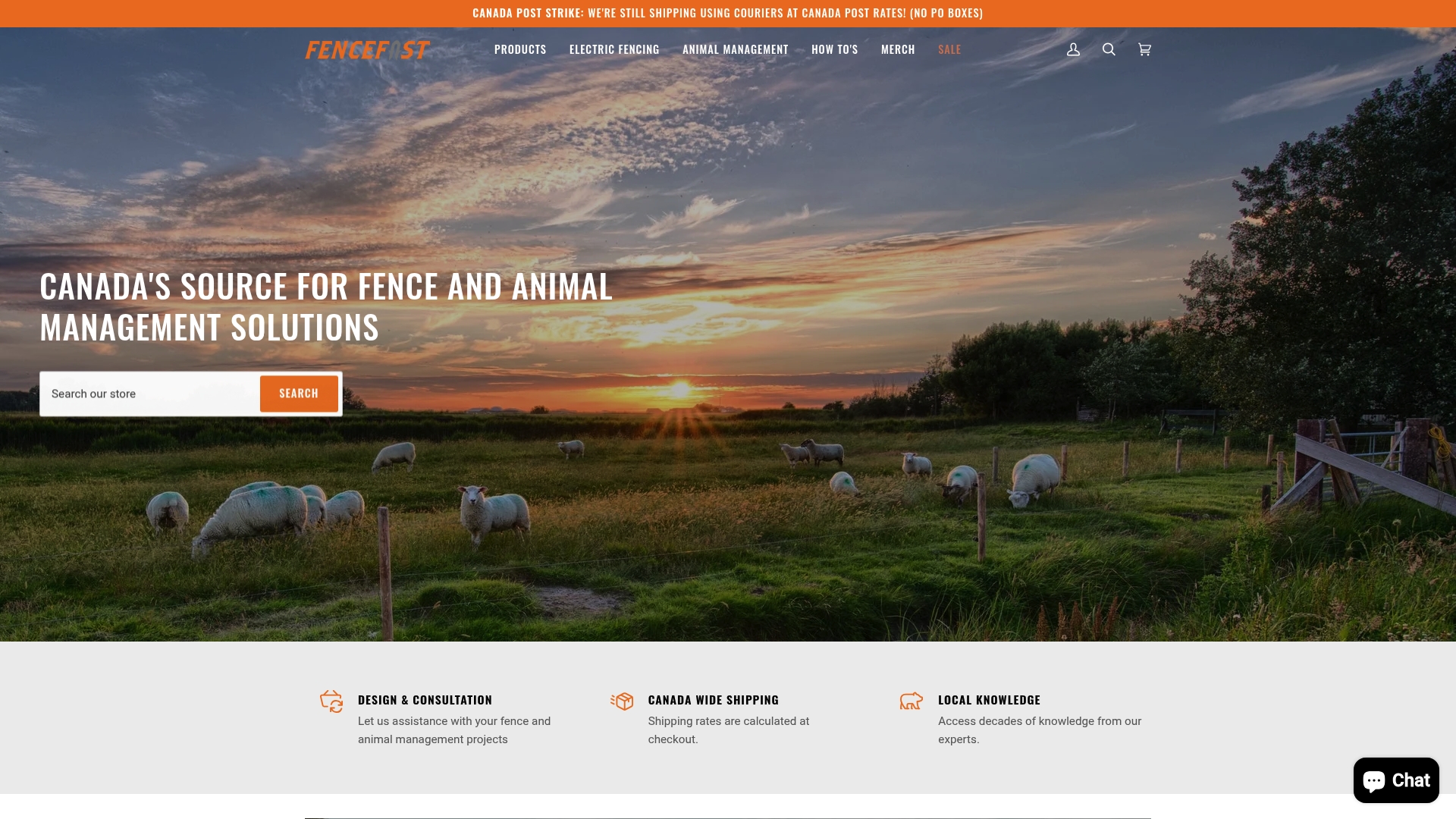Wildlife is constantly crossing onto farms and rural properties, causing unexpected problems for both people and nature. You might think a simple fence would do the trick and keep everyone safe. But only specially engineered wildlife exclusion fencing can reduce animal intrusions by up to 90 percent according to researchers from Colorado State University. The real surprise is that these barriers are not just about blocking paths but reshaping how humans and animals share the land.
Table of Contents
- What Is Wildlife Exclusion Fencing And Its Purpose?
- Why Wildlife Exclusion Fencing Matters For Rural Properties
- How Wildlife Exclusion Fencing Works In Different Environments
- Key Concepts Of Wildlife Exclusion Fencing And Best Practices
Quick Summary
| Takeaway | Explanation |
|---|---|
| Wildlife exclusion fencing protects agriculture. | These fences prevent wildlife from damaging crops and livestock, ensuring economic stability for landowners. |
| Barriers must fit local wildlife needs. | Effective fencing design considers the specific behaviors, movement patterns, and capabilities of the target animal species. |
| Regular maintenance is crucial for effectiveness. | Continuous monitoring and timely repairs are necessary to maintain the integrity and functionality of fencing systems. |
| Environmental conditions influence design strategy. | Different terrains demand tailored fencing solutions to adapt to soil, climate, and vegetation characteristics. |
| Clear boundaries reduce human-wildlife conflicts. | Establishing defined territorial lines minimizes encounters and promotes safety for both humans and wildlife. |
What is Wildlife Exclusion Fencing and Its Purpose?
Wildlife exclusion fencing represents a strategic solution designed to prevent wildlife from entering specific areas, protecting both human interests and animal populations. These specialized barriers are engineered to create physical boundaries that safely redirect animal movements while minimizing potential conflicts between wildlife and human activities.
Understanding the Core Concept
At its fundamental level, wildlife exclusion fencing serves multiple critical purposes across agricultural, conservation, and urban landscapes. Unlike traditional fencing, these systems are meticulously designed with specific materials, heights, and configurations that account for different animal behaviors and capabilities. Learn more about wildlife friendly fencing techniques to understand the nuanced approaches used in these protective barriers.
The primary objectives of wildlife exclusion fencing include:
- Preventing wildlife from accessing crops, livestock, or sensitive ecological zones
- Reducing human wildlife conflicts by establishing clear territorial boundaries
- Protecting endangered species habitats from unintentional human interference
Technical Design and Functionality
Successful wildlife exclusion fencing requires comprehensive understanding of animal movement patterns, jumping capabilities, and burrowing behaviors. These barriers are not simple obstacles but sophisticated systems engineered to account for specific wildlife characteristics.
Effective fencing considers factors like mesh size, material strength, ground penetration depth, and height to create comprehensive protective barriers.
Researchers from Colorado State University Wildlife Management Program have demonstrated that properly constructed wildlife exclusion fencing can reduce animal intrusion by up to 90% in agricultural and conservation settings. The design complexity varies depending on target species, ranging from small rodents to large ungulates like deer and elk.
Wildlife exclusion fencing is not just about creating barriers but establishing intelligent, environmentally conscious boundaries that respect both human needs and animal movement patterns. By strategically implementing these systems, landowners and conservation teams can create sustainable solutions that minimize negative interactions while preserving ecological balance.
Why Wildlife Exclusion Fencing Matters for Rural Properties
Rural properties face numerous challenges related to wildlife interactions that can significantly impact agricultural productivity, economic stability, and ecological balance. Wildlife exclusion fencing emerges as a critical solution for landowners seeking comprehensive protection and sustainable management of their agricultural spaces.
Economic and Agricultural Protection
Wildlife can cause substantial economic damage to rural properties through crop destruction, livestock predation, and resource consumption. Explore essential fencing solutions for small farms to understand the comprehensive strategies available for property management. According to research from the University of Minnesota Agricultural Extension, wildlife interactions cost agricultural producers millions in annual losses.

The primary economic impacts that wildlife exclusion fencing addresses include:
- Preventing crop damage from grazing animals
- Reducing livestock losses from predators
- Minimizing disease transmission between wild and domestic animal populations
- Protecting valuable agricultural infrastructure and equipment
Ecological and Safety Considerations
Beyond economic factors, wildlife exclusion fencing plays a crucial role in maintaining ecological balance and human safety. These sophisticated barriers create designated movement corridors that protect both wildlife and human populations. By strategically implementing exclusion techniques, landowners can:
- Redirect animal migration patterns
- Prevent unintended wildlife human conflicts
- Protect sensitive ecological zones from uncontrolled animal movements
- Maintain biodiversity while establishing clear territorial boundaries
Wildlife exclusion fencing represents more than a physical barrier.
This table compares the primary economic and ecological benefits provided by wildlife exclusion fencing to summarize their role in rural land management.
| Benefit Type | Description |
|---|---|
| Economic Protection | Prevents crop and livestock losses, minimizes related expenses |
| Disease Management | Reduces risk of disease transmission between wild and domestic animals |
| Infrastructure Safety | Protects barns, feeders, and equipment from wildlife damage |
| Ecological Balance | Maintains migration patterns and prevents habitat fragmentation |
| Human Safety | Reduces risk of wildlife encounters and associated injuries |
| It is a nuanced approach to land management that recognizes the complex interactions between human activities and natural ecosystems. Successful implementation requires understanding local wildlife behaviors, landscape characteristics, and specific agricultural needs. By investing in intelligent fencing solutions, rural property owners can create sustainable environments that balance productivity, safety, and ecological preservation. |
How Wildlife Exclusion Fencing Works in Different Environments
Wildlife exclusion fencing represents a sophisticated approach to environmental management, adapting to diverse landscapes and ecological conditions. These specialized barriers are not uniform solutions but dynamic systems engineered to address unique environmental challenges and wildlife behaviors across different terrains.
Terrain and Material Adaptations
Environmental diversity demands flexible fencing strategies that can withstand varying conditions. Check out essential livestock fencing techniques to understand the nuanced approaches used in different settings. According to University of Florida Environmental Research, fencing methods must be carefully adapted to local environmental conditions.
Key environmental considerations include:
The following table organizes the main environmental factors and the corresponding adaptations required for effective wildlife exclusion fencing in different environments.
| Environmental Factor | Design/Material Adaptation |
|---|---|
| Soil composition and stability | Anchored posts, deeper footing, soil-specific hardware |
| Climate and weather patterns | Weather-resistant materials, temperature-tolerant designs |
| Local wildlife species | Height, mesh size, and strength tailored to animal behavior |
| Vegetation density | Adjusted layout for dense areas, reinforced for climbing species |
| Landscape topography | Flexible and contoured fencing, sectional reinforcement |
- Soil composition and ground stability
- Climate and weather patterns
- Local wildlife species and movement behaviors
- Vegetation density and landscape topography
Design Strategies for Specific Environments
Effective wildlife exclusion fencing requires a comprehensive understanding of local ecosystem dynamics. Different environments demand specialized design approaches:
- Mountainous regions require sturdy, anchored fencing with additional ground reinforcement
- Wetlands need elevated or floating barrier systems
- Arid landscapes demand durable materials resistant to extreme temperature fluctuations
- Forest boundaries require more complex designs that account for dense vegetation and varied animal movement patterns
The primary goal of wildlife exclusion fencing is not just physical separation but creating intelligent ecological boundaries that respect both environmental integrity and human land use requirements. By developing nuanced, environment specific fencing solutions, landowners and conservation teams can effectively manage wildlife interactions while preserving natural ecosystem balance.

Key Concepts of Wildlife Exclusion Fencing and Best Practices
Wildlife exclusion fencing represents a sophisticated approach that requires comprehensive understanding of ecological interactions and technical design principles. Successful implementation demands strategic planning, precise engineering, and a holistic perspective on animal behavior and landscape management.
Fundamental Design Principles
Effective wildlife exclusion fencing goes beyond simple physical barriers, incorporating nuanced strategies that consider animal psychology and movement patterns. Explore our comprehensive livestock fencing guide to understand the foundational techniques used in advanced barrier systems. According to research from Oregon State University Wildlife Management Program, successful exclusion strategies require multiple strategic considerations.
Key design principles include:
- Understanding specific wildlife species movement capabilities
- Selecting appropriate material strengths and mesh configurations
- Implementing ground penetration techniques to prevent burrowing
- Creating intelligent redirection zones for animal populations
Performance and Maintenance Considerations
Effective wildlife exclusion fencing demands continuous monitoring and strategic maintenance to ensure long term functionality. The performance of these systems depends on multiple interconnected factors:
- Regular structural integrity assessments
- Prompt repair of damages or weak points
- Seasonal adjustments based on wildlife migration patterns
- Monitoring environmental changes that might impact fence effectiveness
Successful wildlife exclusion fencing transcends traditional boundary creation. It represents a dynamic ecological management tool that balances human infrastructure needs with wildlife conservation principles. By understanding complex interactions between landscape, animal behavior, and infrastructure, landowners and conservation professionals can develop intelligent barriers that protect both human and animal populations while maintaining environmental sustainability.
Protect Your Livelihood with Proven Wildlife Exclusion Fencing Solutions
Are you struggling to safeguard your crops, livestock, and property from the constant threat of wildlife intrusion? The article highlighted how wildlife exclusion fencing can prevent economic losses, protect sensitive areas, and minimize conflicts with animals. Yet, putting theory into practice can feel overwhelming when you are facing daily risks and need practical equipment that actually works for your environment. The need to address animal behavior, environmental conditions, and long term durability is real for every rural property owner.

You do not have to navigate these challenges alone. At FenceFast.ca, you get access to a complete range of fencing components and animal management supplies specifically designed for Canadian conditions. Our products take into account the technical requirements and best practices discussed in this guide, including intelligent barriers, durable materials, and adaptable solutions for different terrains. Ready to minimize wildlife conflicts and protect what matters to you? Visit our main site FenceFast.ca and shop for the fencing solutions recommended by experts and trusted by agricultural customers nationwide. Act now and take control of your property’s safety today.
Frequently Asked Questions
What is the purpose of wildlife exclusion fencing?
Wildlife exclusion fencing serves to prevent wildlife from entering specific areas, protecting crops, livestock, and sensitive ecological zones while minimizing conflicts between wildlife and human activities.
How does wildlife exclusion fencing work in different environments?
Wildlife exclusion fencing is designed to adapt to various landscapes, taking into account factors like soil composition, climate, and local wildlife behaviors to create effective barriers.
What are the key design principles for effective wildlife exclusion fencing?
Effective wildlife exclusion fencing incorporates principles such as understanding animal movement capabilities, selecting appropriate materials, preventing burrowing, and establishing redirection zones to manage wildlife interactions.
How can the performance of wildlife exclusion fencing be maintained?
The performance of wildlife exclusion fencing can be maintained through regular structural assessments, prompt repairs, seasonal adjustments based on wildlife migration patterns, and monitoring environmental changes.
